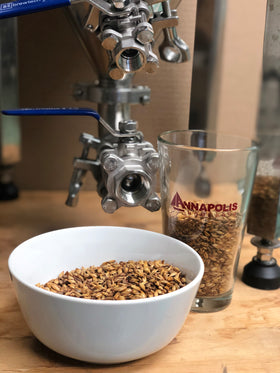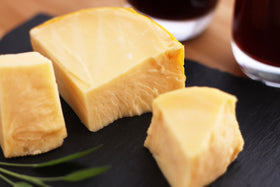Carbonating Bottles
Ever been curious about what the appropriate carbonation level is for your homebrewed and bottled beer? We have the solution for you.
There are two things that the amount of carbonation in bottle conditioned homebrew is dependent on:
- The residual level of carbon dioxide after fermentation
- the amount of carbonation obtained from the priming sugar
The biggest mistake we see people making is not choosing an appropriate level of carbonation for the beer style they have made. To get the desired carbonation you need to first choose the appropriate level and subtract the amount of residual carbonation in your beer after fermentation.
The residual carbonation is the amount of carbonation you must add via priming sugar.
There are 3 priming agents and they are anhydrous glucose, glucose monohydrate and sucrose. The amount of carbonation produced by each of these different priming agents in a 5 Gallon batch of beer is different.
We have included several charts below to help you in determining the correct amounts to craft your next perfect beer.
All of this can sound very complicated, but in reality is pretty straightforward. For example you have created an American Pale Ale at 68 degrees F and you are planning to carbonated it with glucose monohydrate (aka corn sugar). You have decided your desired carbonation level is 2.4 volumes of carbon dioxide, and you then see that you should have 0.85 volumes of carbon dioxide in your beer after fermentation at 68 degrees F. Therefore, subtracting 0.85 from 2.4 gives you 1.55 volumes of carbon dioxide required from the priming sugar for the level of carbonation that you need to make the perfect American Pale Ale.
|
Levels of Carbonation in Various Beer Styles |
|
|
Style |
Volume of CO2 |
|
American Ales |
2.2 – 3.0 |
|
British Ales |
1.5 – 2.2 |
|
German Weizens |
2.8 – 5.1 |
|
Belgian Ales |
2.0 – 4.5 |
|
European Lagers |
2.4 – 2.6 |
|
American Lagers |
2.5 – 2.8 |
|
Residual Carbonation Left Over After Fermentation |
|
|
Temperature (°F/°C) |
Volumes CO2 |
|
47°F (8.33°C) |
1.21 |
|
50°F (10.0°C) |
1.15 |
|
53°F (11.7°C) |
1.09 |
|
56°F (13.3°C) |
1.04 |
|
59°F (15.0°C) |
0.988 |
|
62°F (16.7°C) |
0.940 |
|
65°F (18.3°C) |
0.894 |
|
68°F (20.0°C) |
0.850 |
|
71°F (21.7°C) |
0.807 |
|
74°F (23.3°C) |
0.767 |
|
77°F (25.0°C) |
0.728 |
|
80°F (26.7°C) |
0.691 |
|
83°F (28.3°C) |
0.655 |
|
Carbonation Levels Added to 5 Gallons of Beer by Priming Sugar |
||
|
Priming with Glucose Monohydrate (Dextrose Monohydrate) |
||
|
Glucose H2O (oz.) |
Glucose H2O (g) |
Volumes CO2/19L |
|
1.0 |
28.3 |
0.34 |
|
1.5 |
42.5 |
0.51 |
|
2.0 |
56.7 |
0.68 |
|
2.5 |
70.9 |
0.85 |
|
3.0 |
85.0 |
1.02 |
|
3.5 |
99.2 |
1.19 |
|
4.0 |
113 |
1.36 |
|
4.5 |
128 |
1.53 |
|
5.0 |
142 |
1.70 |
|
5.5 |
156 |
1.87 |
|
6.0 |
170 |
2.04 |
|
6.5 |
184 |
2.21 |
|
7.0 |
198 |
2.37 |
|
7.5 |
213 |
2.54 |
|
8.0 |
227 |
2.71 |
|
8.5 |
241 |
2.88 |
|
9.0 |
255 |
3.05 |
|
Carbonation Levels Added to 5 Gallons of Beer by Priming Sugar |
||
|
Priming with Sucrose |
||
|
Sucrose (oz.) |
Sucrose (g) |
Volumes CO2/19L |
|
1.0 |
28.3 |
0.39 |
|
1.5 |
42.5 |
0.59 |
|
2.0 |
56.7 |
0.79 |
|
2.5 |
70.9 |
0.98 |
|
3.0 |
85.0 |
1.18 |
|
3.5 |
99.2 |
1.37 |
|
4.0 |
113 |
1.57 |
|
4.5 |
128 |
1.77 |
|
5.0 |
142 |
1.96 |
|
5.5 |
156 |
2.16 |
|
6.0 |
170 |
2.36 |
|
6.5 |
184 |
2.55 |
|
7.0 |
198 |
2.75 |
|
7.5 |
213 |
2.95 |
|
8.0 |
227 |
3.14 |
|
8.5 |
241 |
3.34 |
|
9.0 |
255 |
3.54 |
|
Carbonation Levels Added to 5 Gallons of Beer by Priming Sugar |
||
|
Priming with Anhydrous Glucose (Anhydrous Dextrose) |
||
|
Glucose (oz.) |
Glucose (g) |
Volumes CO2/19L |
|
1.0 |
28.3 |
0.37 |
|
1.5 |
42.5 |
0.56 |
|
2.0 |
56.7 |
0.75 |
|
2.5 |
70.9 |
0.93 |
|
3.0 |
85.0 |
1.12 |
|
3.5 |
99.2 |
1.31 |
|
4.0 |
113 |
1.49 |
|
4.5 |
128 |
1.68 |
|
5.0 |
142 |
1.87 |
|
5.5 |
156 |
2.05 |
|
6.0 |
170 |
2.24 |
|
6.5 |
184 |
2.43 |
|
7.0 |
198 |
2.61 |
|
7.5 |
213 |
2.80 |
|
8.0 |
227 |
2.99 |
|
8.5 |
241 |
3.17 |
|
9.0 |
255 |
3.36 |




Leave a comment